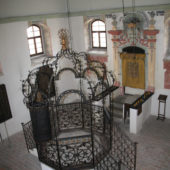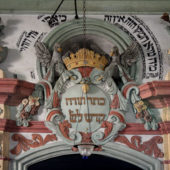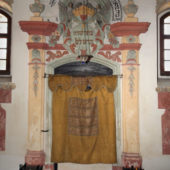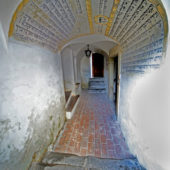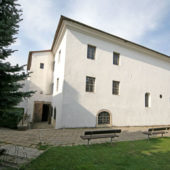The plain, whitewashed exterior belies the lovely, painted interior.
The Holešov Synagogue, or Sach Synagogue as it is often called (for rabbi Sabbatai ben Meir ha-Kohen, aka, Šach), dates back to the year 1560 when it was built to replace the original wooden synagogue that had burned down.
Jews are first mentioned in the records of Holešov by the middle of the 15th century when a Jewish quarter was founded. By the middle of the 16th century, they had carved out a flourishing niche in the town. Constructed in Rennaisance style with a simple, rectangular plan, the synagogue features a main hall with a high ceiling while the southern side of the structure has four floors, including a study located on the top floor. The synagogue was enlarged in 1615 with the addition of a women’s gallery and a sidehall.
An isolated building with a plain, whitewashed exterior, the synagogue doesn’t call a lot of attention to itself. However, the interior décor makes it unique among Czech synagogues. Between 1725 and 1737, it was given a Baroque makeover, often referred to as the “Polish Style,” with painting typified by floral, animal and fruit motifs. The aron ha-kodesh, located in the eastern side of the synagogue, also is a baroque tour de force, with an ornate crest featuring Hebrew script topped by a golden crown and twin birds. Likewise, the main hall is dominated by an elaborate, octagonal platform (alemnor) with metal railings. The walls and ceilings of the women’s gallery upstairs are painted with Hebrew letters bordered in gold. The ceiling of the study also features colorful paintings in the baroque Polish style.
The Jewish community of Holešov reached its peak in the mid 19th century and by the 1890s a new synagogue was built, with the Sach Synagogue relegated largely to storage space. The remaining Jewish population of Holešov was virtually wiped out during the Holocaust and the New Synagogue was destroyed. The Sach Synagogue’s disuse at the time probably contributed to it being saved from destruction. After the war, a handful of Jews returned to their former home, but the Jewish community never was able to reestablish itself during the communist era. Today, the Sach Synagogue is a well preserved example of both the rennaisance and baroque styles and serves as a place of pilgrammage for those coming to honor the memory of this town’s once thriving Jewish community.

